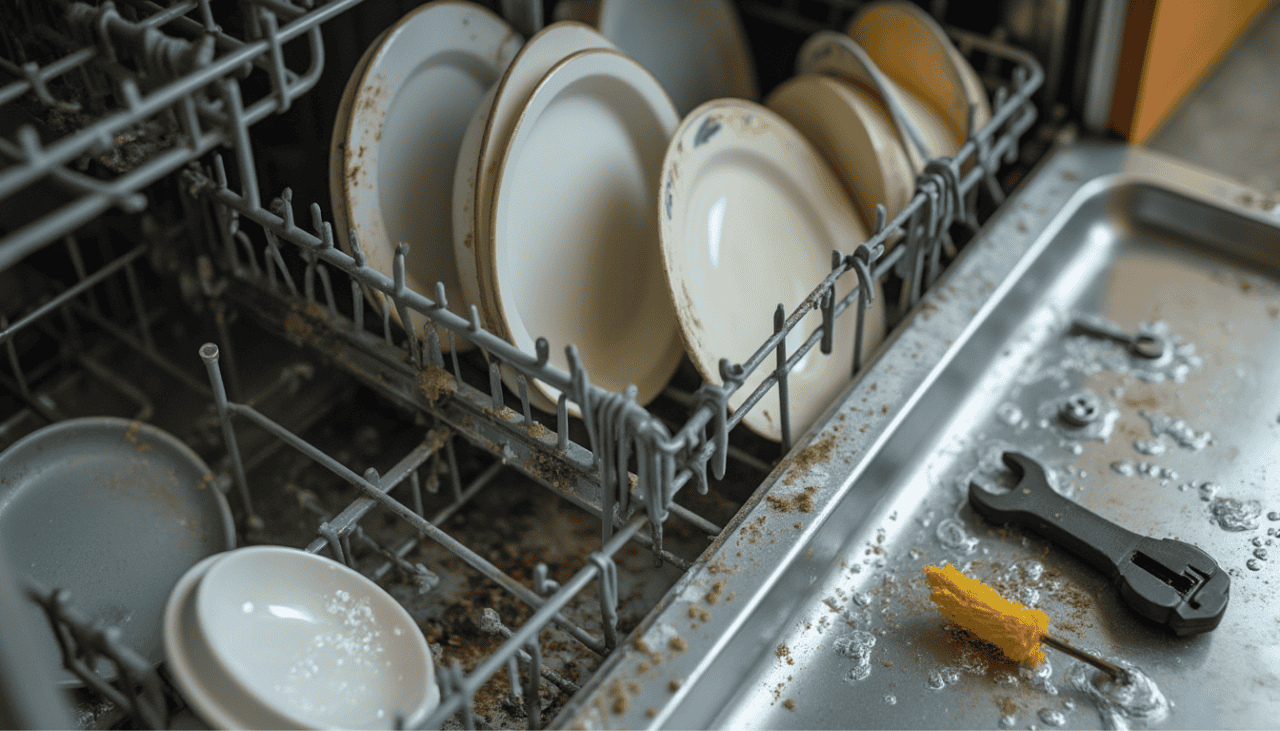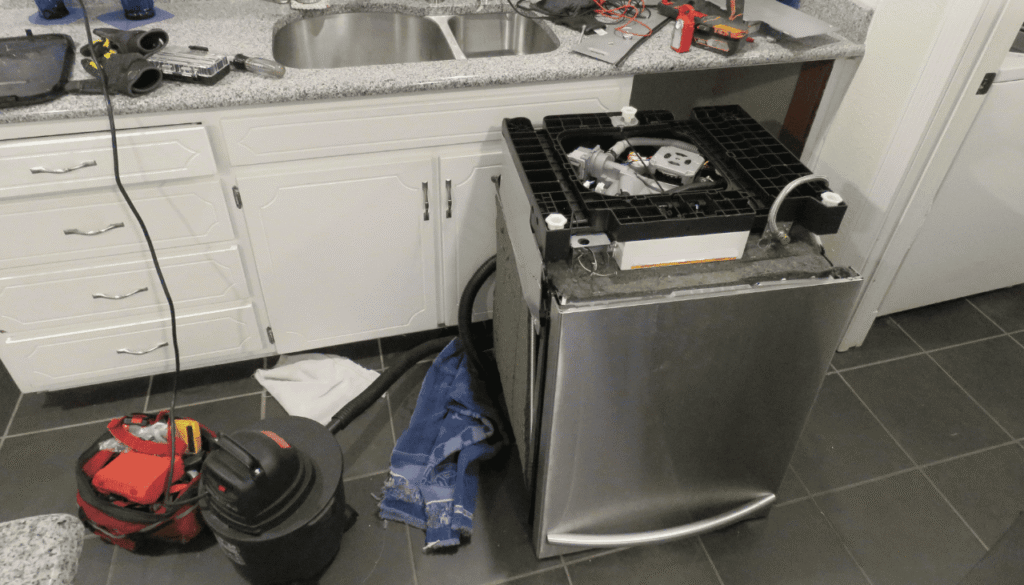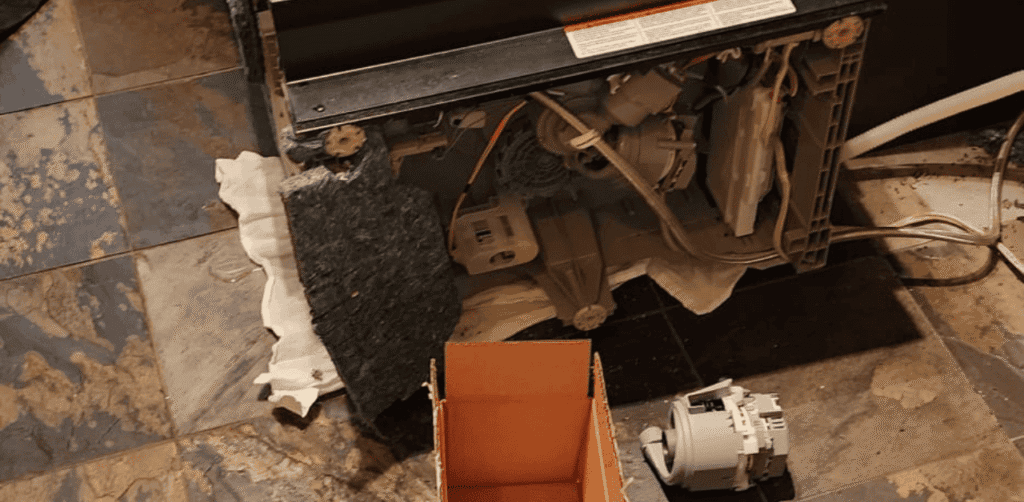A poorly cleaned dishwasher can be fixed through systematic troubleshooting. Common culprits include clogged spray arms, faulty water inlet valves, and malfunctioning detergent dispensers. Start by inspecting and cleaning spray arms, filters, and drainage systems. Check water temperature and pressure, ensuring a minimum of 120°F for excellent cleaning.
Use appropriate detergents based on water hardness and load size. Proper loading techniques, such as avoiding overloading and positioning dishes correctly, greatly impact cleaning effectiveness. Regular maintenance, including descaling and deep cleaning cycles, prevents mineral buildup and enhances performance. For complex issues involving electrical components or persistent problems, professional assistance may be necessary. The following guide provides thorough solutions for restoring your dishwasher’s cleaning power.
Key Takeaways
- Inspect and clean spray arms, filters, and drainage systems to remove clogs and ensure proper water circulation.
- Check water temperature and pressure, ensuring a minimum of 120°F for effective cleaning.
- Use appropriate detergents based on water hardness and load size, incorporating rinse aid for better results.
- Load dishes correctly, avoiding overloading and nesting, to allow optimal water and detergent distribution.
- Regularly maintain the dishwasher through cleaning cycles, descaling treatments, and addressing hard water issues.
Identifying the Root Cause
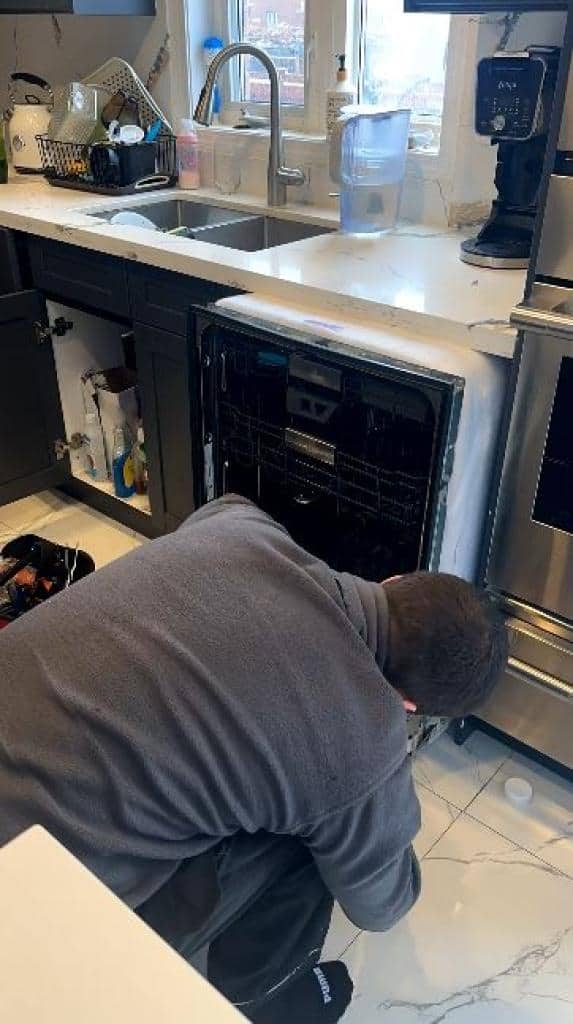
Identifying the root cause of a dishwasher’s poor cleaning performance requires a systematic approach. Common reasons include clogged spray arms, malfunctioning water inlet valves, or faulty detergent dispensers, which can be diagnosed through careful inspection and testing.
Troubleshooting steps for cleaning issues can help identify specific problems and guide you toward effective solutions. While many issues can be resolved with basic troubleshooting, complex problems involving electrical components or water circulation systems may necessitate professional assistance.
Common Reasons for Poor Cleaning Performance
When a dishwasher fails to clean dishes effectively, several common culprits may be responsible. These include accumulation of food particles, clogged spray arms and filters, insufficient water temperature, low water pressure, improper detergent quantity, and overloading.
Drain pump failures can also lead to poor cleaning performance, often indicated by odd noises or water pooling at the bottom of the dishwasher. Regular maintenance and cleaning of key components can help prevent these issues.
Moreover, the buildup of grease and soap scum, malfunctioning soap dispensers, and substandard detergent can hinder cleaning performance. Addressing these issues can vastly improve your dishwasher’s efficiency and restore its cleaning capabilities.
Diagnosing Specific Issues in Your Dishwasher
To effectively address poor cleaning performance, pinpointing the specific issue affecting your dishwasher is paramount. Begin your diagnosis by examining spray arms for clogs, checking detergent dispensers for proper functioning, and inspecting filters for food residue buildup.
Assess water temperature and pressure, and observe the wash cycle for irregularities. If your dishwasher is not receiving water, investigate potential water supply issues, such as a closed water valve or kinked supply line. This systematic problem-solving approach enables precise identification of the root cause, empowering you to implement targeted solutions for excellent cleaning performance.
When to Call a Professional
A clear understanding of when to seek professional assistance is crucial for effective dishwasher maintenance. Consider calling a repair professional for:
| Issue | Professional Intervention |
|---|---|
| Electrical problems | Wiring, control panel |
| Water heating issues | Heating element |
| Persistent leaks | Internal components |
| Unresolved error codes | Diagnostic expertise |
| Complex disassembly | Specialized tools needed |
These situations require technical expertise to diagnose and resolve, ensuring your dishwasher’s ideal performance and longevity.
Mechanical Troubleshooting
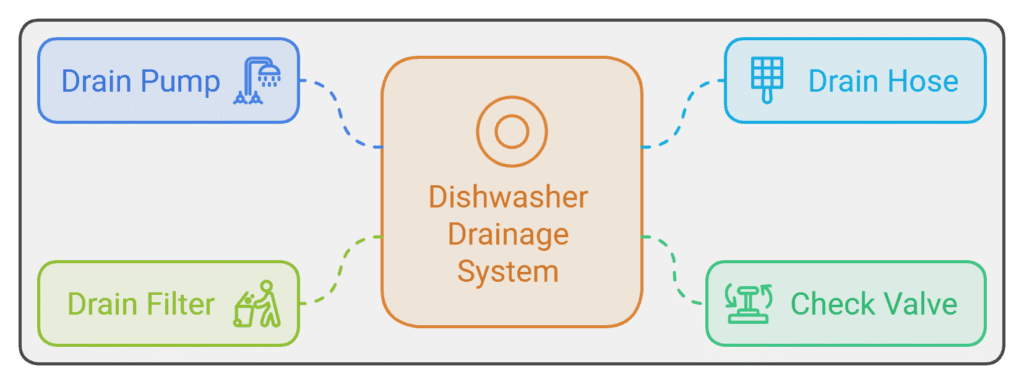
Mechanical troubleshooting a dishwasher that doesn’t clean involves examining key components for proper function. Start by inspecting and cleaning the spray arms, ensuring they rotate freely and their nozzles are unobstructed.
Next, check the pump and motor for proper operation, and thoroughly examine the filters and drainage system for clogs or malfunctions that could impede water flow and cleaning efficiency. If you suspect a clogged drain hose, consider unclogging it to improve drainage and overall cleaning performance.
Inspecting and Cleaning Spray Arms
If you’re experiencing unusual noises during operation, this could also be related to spray arm issues. Properly maintained spray arms contribute to a quieter dishwashing cycle. Remove and clean the arms, unclogging holes and verify free rotation. Check for debris blocking spray arms, and inspect seals.
This maintenance prevents diminished water pressure and coverage, which can impair the pump and motor’s effectiveness in distributing water thoroughly during wash cycles.
Checking the Pump and Motor Function
After verifying the spray arms are clean and functioning correctly, the next step in mechanical troubleshooting involves examining the pump and motor function. A malfunctioning pump or motor can impede water circulation, affecting cleaning performance.
Blocked drain pumps are a common cause of poor dishwasher performance, often resulting in water pooling at the bottom of the appliance. Check the pump for obstructions and confirm it spins freely. Verify the motor runs during wash cycles and that all electrical connections are secure.
Listen for unusual noises, which may indicate the need for component replacement. Professional assistance may be necessary for accessing and testing these parts safely.
Examining Filters and Drainage Systems
A dishwasher’s filtration and drainage systems play a critical role in preserving ideal cleaning performance. Regularly clean filters, whether self-cleaning or removable, to prevent water flow restrictions and guarantee residue-free dishes.
Clogged filters can impede water flow and drainage, often resulting from leftover food, grease, and mineral buildup. Common signs of drainage problems include ineffective cleaning of dishes, bad odours from stagnant water, and the presence of standing water.
Check the drainage system, including the drain hose and pump, for blockages that can lead to standing water. Address issues with the drain valve or water pump promptly. These steps help maintain the peak functionality of spray arms and soap dispensers, regardless of water hardness or mineral content.
Water and Detergent Factors
Water and detergent factors play a vital role in dishwasher performance. Key considerations include ensuring proper water temperature and pressure, selecting an appropriate detergent for your specific dishwasher model, and addressing hard water issues that can affect cleaning efficiency.
Regular filter maintenance and cleaning can also prevent drainage problems that impact overall cleaning effectiveness. By optimizing these elements, users can greatly improve their dishwasher’s cleaning capabilities and overall functionality.
Ensuring Proper Water Temperature and Pressure
Maintaining proper water temperature and pressure is pivotal for exemplary dishwasher performance. Dishwashers require a minimum water temperature of 120°F for effective cleaning. Check your water heater settings or utilize the dishwasher’s heat boost feature. Adequate water pressure is indispensable for optimal distribution during the wash cycle.
| Factor | Action | Impact |
|---|---|---|
| Temperature | Set water heater to 120°F+ | Improves cleaning efficiency |
| Pressure | Check water supply line | Ensures proper water distribution |
| Heat Boost | Activate if available | Maintains consistent temperature |
Choosing the Right Detergent for Your Dishwasher
With water temperature and pressure optimized, attention must shift to selecting the appropriate detergent for your dishwasher. Consider your machine’s specifications and local water hardness when choosing between powder detergent, gel detergent, tablets, or pods.
Troubleshooting soap dispensing issues can help guarantee proper detergent release during the wash cycle. For hard water areas, incorporate a rinse aid to prevent mineral buildup. Eco-friendly detergents are available for environmentally conscious users.
Adjust dishwashing soap quantity based on load size and soil level to avoid residue or incomplete cleaning.
Addressing Hard Water Issues
Many homeowners face challenges with hard water affecting their dishwasher’s performance. Hard water can cause mineral deposits, reducing cleaning effectiveness and increasing energy consumption.
To address this issue, use detergents formulated for hard water and run regular cleaning cycles with products like Lemi Shine. Water softeners may be necessary in areas with very hard water to improve cleaning and drying efficiency.
Regular maintenance and descaling can help mitigate the effects of hard water on your dishwasher. Guarantee proper water temperature and consider a vinegar rinse to combat mineral buildup. These steps can improve cycle duration, water usage, and overall dishwasher performance.
Proper Loading Techniques
Proper loading techniques are vital for optimizing dishwasher performance. Avoiding overloading and nesting dishes guarantees adequate water circulation and detergent distribution.
Utilizing multiple spray zones and flexible wash arms can remarkably enhance cleaning coverage, especially for hard-to-reach areas. Positioning items strategically, with openings facing spray arms and larger cookware on the bottom rack, maximizes cleaning efficiency for different types of dishware and utensils.
Avoiding Overloading and Nesting
Effective loading techniques are crucial for guaranteeing your dishwasher functions at its peak. Avoid overloading and nesting dishes, as these practices impede water circulation and cleaning effectiveness.
Top rack issues often arise from improper loading, so pay special attention to this area when placing items. Distribute items evenly, placing plates, glasses, and cutlery strategically to prevent blockage. Verify large items don’t obstruct spray arms or impede water coverage.
Pre-rinse heavily soiled dishes and position bowls and cups face-down for ideal drainage. Proper dish placement maximizes cleaning efficiency and prevents improper cleaning results.
Positioning Dishes for Optimal Cleaning
Strategic dish positioning is fundamental to achieving ideal cleaning results in your dishwasher. To effectively wash and rinse dirty dishes, load the dishwasher with precision. Proper loading techniques are vital for prime performance and can help maximize the installation investment in your appliance.
Place dishes, pots and pans facing downward to guarantee proper drainage. Distribute heavier items evenly on the lower rack. Space utensils apart to prevent nesting. Maintain adequate gaps between items on both racks for optimal water circulation and a comprehensive cleaning.
Special Considerations for Different Types of Cookware
Various types of cookware require specific loading techniques to guarantee ideal cleaning performance in your dishwasher. Before loading, make certain your dishwasher door closes properly to prevent leaks and maintain optimal cleaning pressure.
For spotless dishes, place delicate glassware and plastics on the top rack of your Bosch, Whirlpool, or KitchenAid appliance. Load heavy pots and pans on the bottom rack for direct spray exposure. Secure small items in the utensil basket, and position dishes with stuck-on food facing the center. These methods help prevent greasy film and ensure thorough cleaning in Miele and Samsung dishwashers.
Maintenance and Prevention
Regular maintenance is essential for ideal dishwasher performance and durability. Implementing a consistent cleaning schedule, including thorough cleaning and descaling treatments, helps prevent buildup and guarantees efficient operation.
Preventing leaks is also a vital part of maintaining your dishwasher, as it can help avoid water damage and costly repairs. Taking proactive measures to protect your dishwasher from potential issues can dramatically reduce the likelihood of future cleaning problems and extend the appliance’s lifespan.
Establishing a Regular Cleaning Routine
To maintain crucial performance and prevent future cleaning issues, establishing a routine maintenance schedule for your dishwasher is indispensable.
Implement a monthly plan that includes inspecting and cleaning the filter, scrubbing the interior, and running a cleaning cycle. Regular maintenance can also help prevent leaks in your dishwasher, which can cause significant damage if left unchecked.
This regular upkeep guarantees exemplary performance and longevity. By incorporating these care practices, you’ll join the ranks of dishwasher owners who enjoy consistently clean dishes and fewer dirty surprises.
Performing Deep Cleans and Descaling
Building upon a regular cleaning routine, deep cleaning and descaling are critical components of dishwasher maintenance. To combat soap scum and mineral buildup, use white vinegar or commercial cleaners. Guarantee proper sanitization by maintaining an ideal water temperature. Descaling enhances cleaning performance and prevents disinfection issues.
| Component | Cleaning Method | Frequency |
|---|---|---|
| Filters | Soak and scrub | Monthly |
| Spray arms | Vinegar solution | Quarterly |
| Interior | Damp cloth + baking soda | Weekly |
Protecting Your Dishwasher from Future Issues
Maintaining your dishwasher’s ideal performance hinges on implementing a proactive approach to prevention and routine care. Efficient resource management includes regularly cleaning filters, spray arms, and interior surfaces to prevent debris buildup.
One common issue that can affect performance is when the dishwasher isn’t heating water properly, which can lead to poor cleaning results. Properly adjust the water temperature to 120°F for optimal sanitization. Check the spray arms for clogs, and use quality detergent with rinse aid.
Periodically run cleaning cycles with vinegar to preserve the appliance’s effectiveness and guarantee dishes come out clean and dry.

